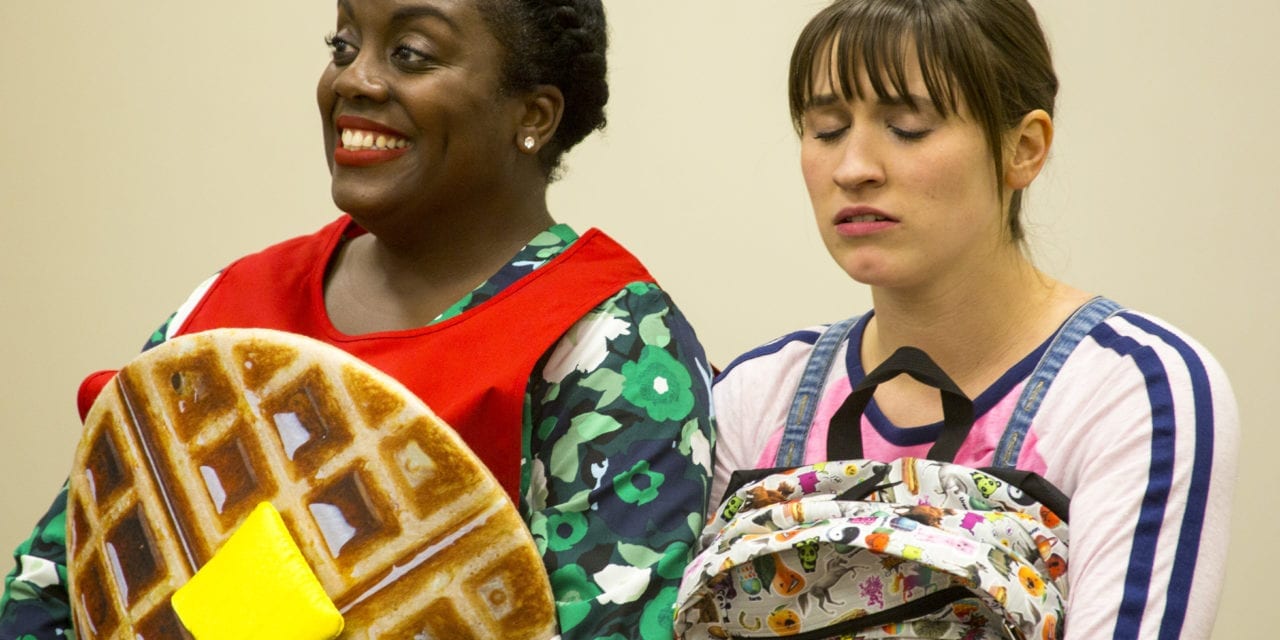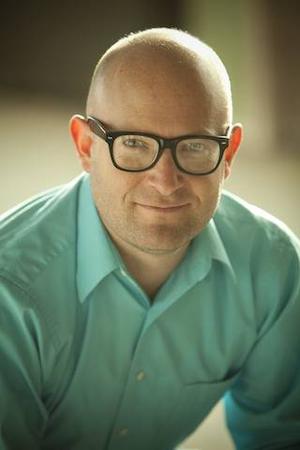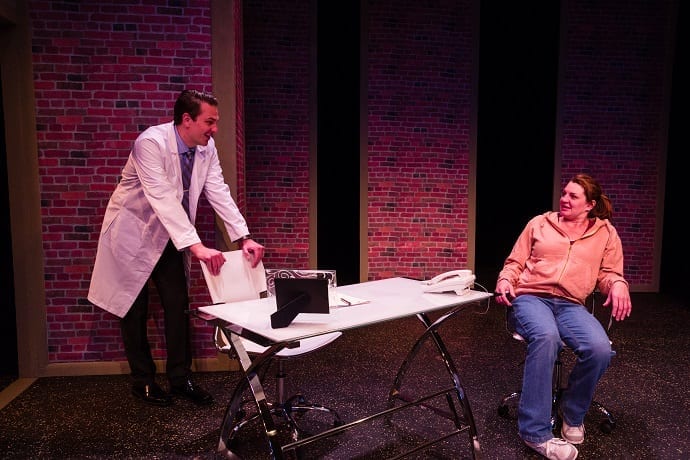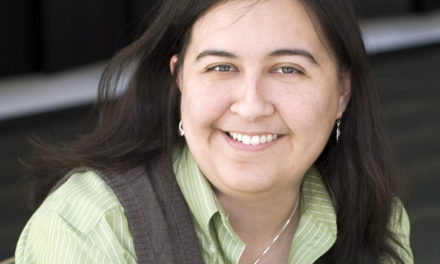Plan-B Theatre Company extended its mission to produce socially conscious theatre pieces to include a new and younger generation by launching FEST ( the Free Elementary School Tour) in 2013. This six year initiative has included a half hour version of Prokofiev’s Peter and the Wolf, Matthew Ivan Bennett’s DIFFERENT= AMAZING, and last year’s RUFF! by Jenifer Nii. 2016 brings us Melissa Leilani Larson’s The Edible Complex, a piece about a 10-year old who dreams of becoming a chef, but is also confronted with societal expectations about her body. Larson gives UTBA the skinny on how her new play came about and some other delicious details.
 Your last collaboration with Plan-B was 2015’s Pilot Program. What inspired this new project?
Your last collaboration with Plan-B was 2015’s Pilot Program. What inspired this new project?
LARSON: I’ve wanted to write something touching on eating disorders and body image for a long, long time. But I didn’t want to tread familiar ground, and I didn’t want to do an after school special. For a really long time, it felt like every time I broached the subject, nothing worked. It was all trite. The problem, it turns out, is that I was initially trying to write an issue play for college students and it wasn’t going to be anything but pedantic. It just wasn’t going to work. A couple of years ago, Jerry at Plan-B asked me to write a play aimed at young audiences—specifically grades 4-6—for their elementary school tour. He asked me what I wanted to write about. I had no idea. I had a cool title and I knew I wanted to do something about body image, but I had no play to go with it. Jerry said a play about positive body image was awesome! All of a sudden I had a deadline and a new audience, which ended up making all the difference.
Is this your first play for young audiences? What were the biggest differences or challenges writing for children as opposed to adult audiences?
LARSON: It’s my first in a long, long while. In school I partnered with someone on a TYA (Theatre for Young Audiences) piece that played around with language—songs and rhyming. It’s awesome, but it’s tricky. Kids are very open about what they like and don’t like. They’re extremely discerning. They don’t want to be pandered to; they want to have a good time, and they want to know something they didn’t know before. I was intimidated at first. But the thing about writing for kids is that really it’s just like writing for adults. You tell a story as best you can, to a particular audience, in a particular time frame. Don’t talk down. Be honest.
The Edible Complex has several characters that are food personified. What was the process for giving personalities to familiar dishes?
LARSON: I kind of envisioned the whole thing as a romantic comedy. Anna is a foodie in the making. She loves food. She thinks about it all the time. At the start of the show, she decides she’s going to stop eating. Each food wants to be the one to talk her into coming back. They all try different ways to coerce her into eating something—and she uses a lot of familiar break-up tropes to disappoint them. The way I see it, there is nothing each food wants more than to be eaten—you can liken it unto people wanting to be loved. So when Anna says “No, thanks,” it’s a big deal. The stakes are actually pretty high. So the stakes combined with a lot of food I know well and like a lot… Well, those foods suddenly had clear personalities. In performing them, Dee-Dee (Darby-Duffin, the play’s co-star) is able to find even more personality. I’m hoping that kids will see a food they might not normally care for in the show and give it another shot at home.

L-R: Anne Louise Brings, Dee-Dee Darby-Duffin
Do you have a favorite line, character, or moment in The Edible Complex?
LARSON: I’ll admit, I have a bunch. One of my favorite stage directions comes after Anna stands her ground and says no to some chicken wings: “The chicken wings are sad.” There are a couple of moments when I think Anna really shows that she might just be a great chef one day. One of those is a moment during which her Mom says that Anna is the only person she knows who enjoys peeling potatoes. Anna’s response is simple: “It makes a nice noise. The peeler.” I knew then that Anna really belonged in a kitchen, and I was glad; I felt like the character had become a real person.
There is obviously a lot of love involved in this project for you. Is the subject matter personal for you? Or is this a magical kind of project that has brought out the love?

Anne Louise Brings
What do you find is the biggest benefit for writing for the stage versus other writing? What is your biggest challenge?
LARSON: The biggest benefit in live performance is the energy given off by the audience. With an audience that is in the moment, the actors can take that energy and use it and it’s amazing. The trade-off is that you have to be hyper-aware of what you can and can’t do in a theatrical space. Yes, you can do just about everything, but it takes care and planning. I can very easily cut between several locations in a screenplay; in a play, I need to find another way to get that information across. It’s a challenge, but a fun challenge.
Whose work would you recommend emerging writers to study?
LARSON: Everyone has a voice and particular style. I think it’s a good choice to find successful plays that are similar in tone and style and character to what you want to do. For me, that includes British playwrights Helen Edmundson and Polly Teale, who are both great at mixing theatricality with literariness, and Sarah Ruhl, who is a poet with an eye for amazing stage pictures. Right now, if I could pick any playwright and I say I wish I was her, I’d pick Lauren Gunderson. I love the subjects she writes about, and the way her characters talk to one another; doesn’t hurt that she’s hot stuff, getting produced everywhere. She writes honest, flawed, fascinating women, which is exactly what I want to do. I saw her play The Revolutionists, about women caught up in the French Revolution, earlier this year. It was great. I sat there, enraptured, and thought—This. I want to do this. I would also suggest paying attention to what the regional theatres across the country are producing, even if those plays don’t necessarily fall into your wheelhouse. It’s always good to keep an eye on what’s popular, and to watch how trends ebb and flow.
What is your dream project? Who would you like to collaborate with?

Dee-Dee Darby-Duffin
LARSON: I think the big dream right now is to make it to the next level. I’ve had some pretty solid success in academic theatre, and I’ve had a great experience working at Plan-B, where Pilot Program was my first professional production. The dream is to be produced at a regional theatre. Somewhere like the Guthrie or the Goodman or Looking Glass or South Coast Rep or Playhouse in the Park… The dream list is a long list. If we’re talking about one crazy, huge, no-holdsbarred, million-dollar budget, dream project… I would do a Broadway musical about a Filipino family immigrating to Hawai’i in the 1970s. And—this is the dreamy part—it would star Lea Salonga, Joanna Ampil, Ruthie Ann Miles, and Phillipa Soo. Bam.
If you could have dinner with anyone, living or dead, who would it be and why? (and what would you like to eat at this dinner?)
LARSON: Henry VIII in his heyday, the early 1530s. The meal would be a Renaissance feast: probably goose and some fabulous bread and a lot of wine. I would probably just watch him eat, to be honest. It would possibly be horrible, but I don’t think I could look away.
What is your #1 comfort food? What is your guilty pleasure?
LARSON: Fresh buttered popcorn. I could eat it all day. As for guilty pleasures, I do like a Coca-Cola with most everything.
What is next for you?
LARSON: I’m working on a piece, Sweetheart Come, about a young mother dealing with schizophrenia in the early 20th century. It was an O’Neill semi-finalist this year and I feel really good about its progress; I’d love to see something happen with it. I’ve started drafting a new play, Pit Bull, about a defense lawyer losing her touch. I was invited to be part of a new works initiative at the Covey Center for the Arts in Provo, where I’ll be workshopping a new adaptation of Jane Austen’s Emma starting in January; it will have a staged reading in May. I’m also working on a couple of screenplays.

L-R: Dee-Dee Darby-Duffin, Anne Louise Brings





